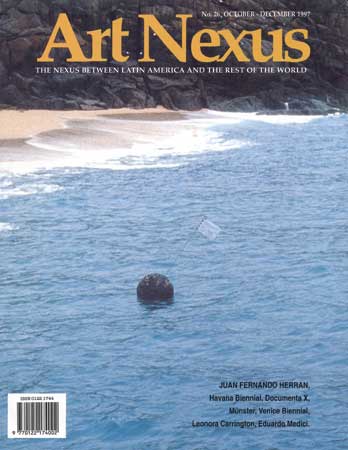Art Nexus
Alejandra Pozo
October – December 1997
From: Pozo, Alejandra: Bodies of artists in full action. Performances at and around the Sixth Havana Biennial, Art Nexus, no.26, Oct.-Dec., 1997. (ilust.) pp.77-79. (Review).
Bodies of Artists in Full Action
Alejandra Pozo
Performance art has become on of the most authentic forms of artistic expression in Cuba in recent decades and one which has been able to confront the officialdom which was gradually asphyxiating creative freedom in the country. Today things are not censured, merely ignored, and once again there are spacious undergrounds where free artistic expression is possible. During the sixth edition of the Havana Biennial, and within its officialist framework, performance art co-existed alongside other expressions, and was also on full view in the off Biennial.
The next evening, Tania Bruguera and Coco Fusco, Cuban artists whose works were not included in this edition of the Biennial offered performances in the house of the former. Bruguera, an artist and performer who represented Cuba at the last edition of the Sao Paulo Biennial, awaited at the entrance to her house opposite a handsome Cuban flag which she had made with human hair; she was barefoot and dressed in white and with the headless body of a lamb around her chest like a cuirass. There was a pot of Cuban earth in front of her, along with a deep plate of water and salt. In an almost mechanical act of submission and resignation, she mixed in her hands a small amount of earth with the tearful water, raised it to her mouth, chewed and then swallowed it. The Weight of Guilt was the title of the action, and the artist spent almost an hour eating earth in a calm and ritualistic manner. In a back room in the same house, Coco Fusco, a Cuban artist who lives in New York, was interpreting his dead grandmother, under a white sheet along with her few personal belongings, with the ight of a black neon above A text at the entrance illustrated a family anecdote according to which his grandmother had left her native town to go first to Havana and later to the United States, until, just before her death, she decided to travel to Barcelona, Spain, and thus abandon the arduous life of exile. The day that Coco Fusco went to identify the body in Spain, he saw only the object with which she had remained up until the last moment – a pair of glasses and her purse. Perhaps she had left all the rest in CUba many years ago. Fusco’s work, with its handsome visual and aesthetic poetics, evoked the concern of so many of the older Cubans who have gone into exile, the anguish of dying outside their homeland. These performances also marked the inauguration of a new project by Tania Bruguera, consisting of the establishment of an artistic space, Tejadillo 214, which will operate from her own house as a venue for conceptual works and performances within a double kind of cultural project – i.e. not only showing the experiences of Cuban artists, but bringing to Cuba foreign artist to share with the cultured inquisitive and respectful local public.
